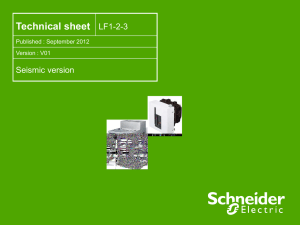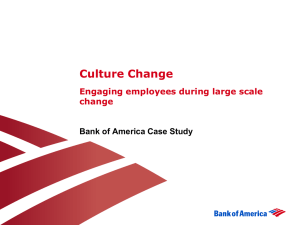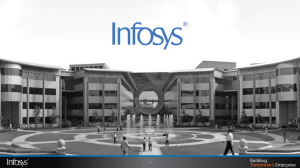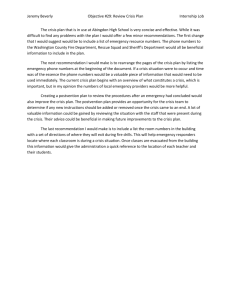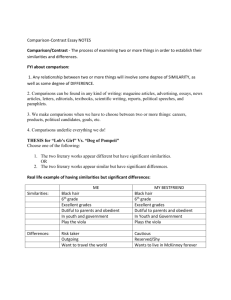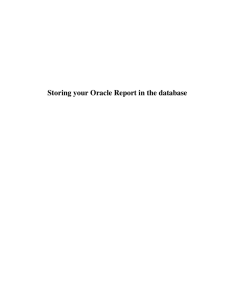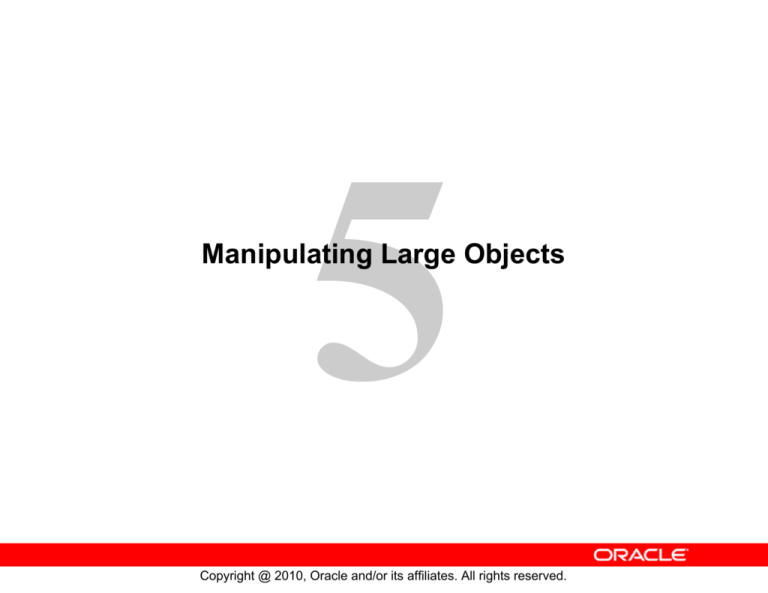
Manipulating Large Objects
Copyright @ 2010, Oracle and/or its affiliates. All rights reserved.
Objectives
After completing this lesson, you should be able to do the
following:
• Create and maintain LOB data types
• Differentiate between internal and external LOBs
• Use the DBMS_LOB PL/SQL package
• Describe the use of temporary LOBs
• Enable SecureFile LOB deduplication, compression, and
encryption
• Migrate BasicFile LOBs to the SecureFile LOB format
5-2
Copyright @ 2010, Oracle and/or its affiliates. All rights reserved.
Lesson Agenda
•
•
•
•
•
5-3
Introduction to LOBs
Managing BFILEs by using the DBMS_LOB package
Manipulating LOB data
Using temporary LOBs
Using SecureFile LOB
Copyright @ 2010, Oracle and/or its affiliates. All rights reserved.
What Is a LOB?
LOBs are used to store large, unstructured data such as text,
graphic images, films, and sound waveforms.
“Four score and seven years
ago, our forefathers brought
forth upon this continent, a
new nation, conceived in
LIBERTY, and dedicated to the
proposition that all men are
created equal.”
Text (CLOB)
5-4
Movie (BFILE)
Photo (BLOB)
Copyright @ 2010, Oracle and/or its affiliates. All rights reserved.
Components of a LOB
The LOB column stores a locator to the LOB’s value.
LOB locator
LOB column
of a table
5-6
LOB value
Copyright @ 2010, Oracle and/or its affiliates. All rights reserved.
Internal LOBs
The LOB value is stored in the database.
“Four score and seven years ago,
our forefathers brought forth upon
this continent, a new nation,
conceived in LIBERTY, and dedicated
to the proposition that all men
are created equal.”
CLOB
5-7
BLOB
Copyright @ 2010, Oracle and/or its affiliates. All rights reserved.
Managing Internal LOBs
•
To interact fully with LOB, file-like interfaces are provided
in:
– The DBMS_LOB PL/SQL package
–
–
–
–
•
5-8
Oracle Call Interface (OCI)
Oracle Objects for object linking and embedding (OLE)
Pro*C/C++ and Pro*COBOL precompilers
Java Database Connectivity (JDBC)
The Oracle server provides some support for LOB
management through SQL.
Copyright @ 2010, Oracle and/or its affiliates. All rights reserved.
Lesson Agenda
•
•
•
•
•
5-9
Introduction to LOBs
Managing BFILEs by using the DBMS_LOB package
Manipulating LOB data
Using temporary LOBs
Using SecureFile LOB
Copyright @ 2010, Oracle and/or its affiliates. All rights reserved.
What Are BFILEs?
The BFILE data type supports an external or file-based large
object as:
• Attributes in an object type
• Column values in a table
Movie (BFILE)
5 - 10
Copyright @ 2010, Oracle and/or its affiliates. All rights reserved.
Securing BFILEs
User
Access
permissions
Movie (BFILE)
5 - 11
Copyright @ 2010, Oracle and/or its affiliates. All rights reserved.
What Is a DIRECTORY?
User
DIRECTORY
LOB_PATH =
'/oracle/lob/'
Movie (BFILE)
5 - 12
Copyright @ 2010, Oracle and/or its affiliates. All rights reserved.
Using the DBMS_LOB Package
•
•
•
•
Working with LOBs often requires the use of the Oraclesupplied DBMS_LOB package.
LOB data can be retrieved directly using SQL.
In PL/SQL, you can define a VARCHAR2 for a CLOB and a
RAW for a BLOB.
DBMS_LOB provides routines to access and manipulate
internal and external LOBs.
– Modify LOB values:
APPEND, COPY, ERASE, TRIM, WRITE, LOADFROMFILE
– Read or examine LOB values:
GETLENGTH, INSTR, READ, SUBSTR
– Specific to BFILEs:
FILECLOSE, FILECLOSEALL, FILEEXISTS,
FILEGETNAME, FILEISOPEN, FILEOPEN
5 - 13
Copyright @ 2010, Oracle and/or its affiliates. All rights reserved.
DBMS_LOB.READ and DBMS_LOB.WRITE
PROCEDURE READ (
lobsrc IN BFILE|BLOB|CLOB ,
amount IN OUT BINARY_INTEGER,
offset IN INTEGER,
buffer OUT RAW|VARCHAR2 )
PROCEDURE WRITE (
lobdst IN OUT BLOB|CLOB,
amount IN OUT BINARY_INTEGER,
offset IN INTEGER := 1,
buffer IN RAW|VARCHAR2 ) -- RAW for BLOB
5 - 14
Copyright @ 2010, Oracle and/or its affiliates. All rights reserved.
Managing BFILEs
The DBA or the system administrator:
1. Creates an OS directory and supplies files
2. Creates a DIRECTORY object in the database
3. Grants the READ privilege on the DIRECTORY object to the
appropriate database users
The developer or the user:
4. Creates an Oracle table with a column that is defined as a
BFILE data type
5. Inserts rows into the table by using the BFILENAME
function to populate the BFILE column
6. Writes a PL/SQL subprogram that declares and initializes a
LOB locator, and reads BFILE
5 - 15
Copyright @ 2010, Oracle and/or its affiliates. All rights reserved.
Preparing to Use BFILEs
1. Create an OS directory to store the physical data files:
mkdir /home/oracle/labs/DATA_FILES/MEDIA_FILES
2. Create a DIRECTORY object by using the CREATE
DIRECTORY command:
CREATE OR REPLACE DIRECTORY data_files AS
'/home/oracle/labs/DATA_FILES/MEDIA_FILES';
3. Grant the READ privilege on the DIRECTORY object to the
appropriate users:
GRANT READ ON DIRECTORY data_files TO OE;
5 - 16
Copyright @ 2010, Oracle and/or its affiliates. All rights reserved.
Populating BFILE Columns with SQL
•
Use the BFILENAME function to initialize a BFILE column.
The function syntax is:
FUNCTION BFILENAME(directory_alias IN VARCHAR2,
filename IN VARCHAR2)
RETURN BFILE;
•
Example:
– Add a BFILE column to a table:
ALTER TABLE customers ADD video BFILE;
– Update the column using the BFILENAME function:
UPDATE customers
SET video = BFILENAME('DATA_FILES', 'Winters.avi')
WHERE customer_id = 448;
5 - 17
Copyright @ 2010, Oracle and/or its affiliates. All rights reserved.
Populating a BFILE Column with PL/SQL
CREATE PROCEDURE set_video(
dir_alias VARCHAR2, custid NUMBER) IS
filename VARCHAR2(40);
file_ptr BFILE;
CURSOR cust_csr IS
SELECT cust_first_name FROM customers
WHERE customer_id = custid FOR UPDATE;
BEGIN
FOR rec IN cust_csr LOOP
filename := rec.cust_first_name || '.gif';
file_ptr := BFILENAME(dir_alias, filename);
DBMS_LOB.FILEOPEN(file_ptr);
UPDATE customers SET video = file_ptr
WHERE CURRENT OF cust_csr;
DBMS_OUTPUT.PUT_LINE('FILE: ' || filename ||
' SIZE: ' || DBMS_LOB.GETLENGTH(file_ptr));
DBMS_LOB.FILECLOSE(file_ptr);
END LOOP;
END set_video;
5 - 18
Copyright @ 2010, Oracle and/or its affiliates. All rights reserved.
Using DBMS_LOB Routines with BFILEs
The DBMS_LOB.FILEEXISTS function can check whether the
file exists in the OS. The function:
• Returns 0 if the file does not exist
• Returns 1 if the file does exist
CREATE OR REPLACE FUNCTION get_filesize(p_file_ptr IN
OUT BFILE)
RETURN NUMBER IS
v_file_exists BOOLEAN;
v_length NUMBER:= -1;
BEGIN
v_file_exists := DBMS_LOB.FILEEXISTS(p_file_ptr) = 1;
IF v_file_exists THEN
DBMS_LOB.FILEOPEN(p_file_ptr);
v_length := DBMS_LOB.GETLENGTH(p_file_ptr);
DBMS_LOB.FILECLOSE(p_file_ptr);
END IF;
RETURN v_length;
END;
/
5 - 19
Copyright @ 2010, Oracle and/or its affiliates. All rights reserved.
Lesson Agenda
•
•
•
•
•
5 - 20
Introduction to LOBs
Managing BFILEs by using the DBMS_LOB package
Manipulating LOB data
Using temporary LOBs
Using SecureFile LOB
Copyright @ 2010, Oracle and/or its affiliates. All rights reserved.
Initializing LOB Columns Added to a Table
•
Add the LOB columns to an existing table by using ALTER
TABLE.
ALTER TABLE customers
ADD (resume CLOB, picture BLOB);
•
Create a tablespace where you will put a new table with
the LOB columns.
CREATE TABLESPACE lob_tbs1
DATAFILE 'lob_tbs1.dbf' SIZE 800M REUSE
EXTENT MANAGEMENT LOCAL
UNIFORM SIZE 64M
SEGMENT SPACE MANAGEMENT AUTO;
5 - 21
Copyright @ 2010, Oracle and/or its affiliates. All rights reserved.
Initializing LOB Columns Added to a Table
Initialize the column LOB locator value with the DEFAULT option
or the DML statements using:
• EMPTY_CLOB() function for a CLOB column
• EMPTY_BLOB() function for a BLOB column
CREATE TABLE customer_profiles (
id NUMBER,
full_name
VARCHAR2(45),
resume
CLOB DEFAULT EMPTY_CLOB(),
picture
BLOB DEFAULT EMPTY_BLOB())
LOB(picture) STORE AS BASICFILE
(TABLESPACE lob_tbs1);
5 - 22
Copyright @ 2010, Oracle and/or its affiliates. All rights reserved.
Populating LOB Columns
•
Insert a row into a table with LOB columns:
INSERT INTO customer_profiles
(id, full_name, resume, picture)
VALUES (164, 'Charlotte Kazan', EMPTY_CLOB(), NULL);
•
Initialize a LOB using the EMPTY_BLOB() function:
UPDATE customer_profiles
SET resume = 'Date of Birth: 8 February 1951',
picture = EMPTY_BLOB()
WHERE id = 164;
•
Update a CLOB column:
UPDATE customer_profiles
SET resume = 'Date of Birth: 1 June 1956'
WHERE id = 150;
5 - 23
Copyright @ 2010, Oracle and/or its affiliates. All rights reserved.
Writing Data to a LOB
•
•
Create the procedure to read the MS Word files and load
them into the LOB column.
Call this procedure from the WRITE_LOB procedure
(shown on the next page).
CREATE OR REPLACE PROCEDURE loadLOBFromBFILE_proc
(p_dest_loc IN OUT BLOB, p_file_name IN VARCHAR2,
p_file_dir IN VARCHAR2)
IS
v_src_loc BFILE := BFILENAME(p_file_dir, p_file_name);
v_amount
INTEGER := 4000;
BEGIN
DBMS_LOB.OPEN(v_src_loc, DBMS_LOB.LOB_READONLY);
v_amount := DBMS_LOB.GETLENGTH(v_src_loc);
DBMS_LOB.LOADFROMFILE(p_dest_loc, v_src_loc, v_amount);
DBMS_LOB.CLOSE(v_src_loc);
END loadLOBFromBFILE_proc;
5 - 24
Copyright @ 2010, Oracle and/or its affiliates. All rights reserved.
Writing Data to a LOB
Create the procedure to insert LOBs into the table:
CREATE OR REPLACE PROCEDURE write_lob
(p_file IN VARCHAR2, p_dir IN VARCHAR2)
IS
i
NUMBER;
v_fn VARCHAR2(15);
v_ln VARCHAR2(40);
v_b BLOB;
BEGIN
DBMS_OUTPUT.ENABLE;
DBMS_OUTPUT.PUT_LINE('Begin inserting rows...');
FOR i IN 1 .. 30 LOOP
v_fn:=SUBSTR(p_file,1,INSTR(p_file,'.')-1);
v_ln:=SUBSTR(p_file,INSTR(p_file,'.')+1,LENGTH(p_file)INSTR(p_file,'.')-4);
INSERT INTO customer_profiles
VALUES (i, v_fn, v_ln, EMPTY_BLOB())
RETURNING picture INTO v_b;
loadLOBFromBFILE_proc(v_b,p_file, p_dir);
DBMS_OUTPUT.PUT_LINE('Row '|| i ||' inserted.');
END LOOP;
COMMIT;
END write_lob;
5 - 25
Copyright @ 2010, Oracle and/or its affiliates. All rights reserved.
Writing Data to a LOB
CREATE OR REPLACE DIRECTORY resume_files AS
'/home/oracle/labs/DATA_FILES/RESUMES';
set serveroutput on
set verify on
set term on
timing start load_data
execute write_lob('karl.brimmer.doc', 'RESUME_FILES')
execute write_lob('monica.petera.doc', 'RESUME_FILES')
execute write_lob('david.sloan.doc',
'RESUME_FILES')
timing stop
5 - 26
Copyright @ 2010, Oracle and/or its affiliates. All rights reserved.
Reading LOBs from the Table
CREATE OR
REPLACE
PROCEDURE
read_lob
Create
the
procedure
to read
LOBs from the table:
IS
v_lob_loc
BLOB;
CURSOR profiles_cur IS
SELECT id, full_name, resume, picture
FROM customer_profiles;
v_profiles_rec
customer_profiles%ROWTYPE;
BEGIN
OPEN profiles_cur;
LOOP
FETCH profiles_cur INTO v_profiles_rec;
v_lob_loc := v_profiles_rec.picture;
DBMS_OUTPUT.PUT_LINE('The length is: '||
DBMS_LOB.GETLENGTH(v_lob_loc));
DBMS_OUTPUT.PUT_LINE('The ID is: '|| v_profiles_rec.id);
DBMS_OUTPUT.PUT_LINE('The blob is read: '||
UTL_RAW.CAST_TO_VARCHAR2(DBMS_LOB.SUBSTR(v_lob_loc,200,1)));
EXIT WHEN profiles_cur%NOTFOUND;
END LOOP;
CLOSE profiles_cur;
END;
5 - 28
Copyright @ 2010, Oracle and/or its affiliates. All rights reserved.
Updating LOB by Using DBMS_LOB in PL/SQL
DECLARE
v_lobloc CLOB;
-- serves as the LOB locator
v_text
VARCHAR2(50) := 'Resigned = 5 June 2000';
v_amount NUMBER ; -- amount to be written
v_offset INTEGER; -- where to start writing
BEGIN
SELECT resume INTO v_lobloc FROM customer_profiles
WHERE id = 164 FOR UPDATE;
v_offset := DBMS_LOB.GETLENGTH(v_lobloc) + 2;
v_amount := length(v_text);
DBMS_LOB.WRITE (v_lobloc, v_amount, v_offset, v_text);
v_text := ' Resigned = 30 September 2000';
SELECT resume INTO v_lobloc FROM customer_profiles
WHERE id = 150 FOR UPDATE;
v_amount := length(v_text);
DBMS_LOB.WRITEAPPEND(v_lobloc, v_amount, v_text);
COMMIT;
END;
5 - 30
Copyright @ 2010, Oracle and/or its affiliates. All rights reserved.
Checking the Space Usage of a LOB Table
CREATE OR REPLACE PROCEDURE check_space
IS
l_fs1_bytes NUMBER;
l_fs2_bytes NUMBER; ...
BEGIN
DBMS_SPACE.SPACE_USAGE(
segment_owner
=> 'OE',
segment_name
=> 'CUSTOMER_PROFILES',
segment_type
=> 'TABLE',
fs1_bytes
=> l_fs1_bytes,
fs1_blocks
=> l_fs1_blocks,
fs2_bytes
=> l_fs2_bytes,
fs2_blocks
=> l_fs2_blocks, ...
);
DBMS_OUTPUT.ENABLE;
DBMS_OUTPUT.PUT_LINE(' FS1 Blocks = '||l_fs1_blocks||'
Bytes = '||l_fs1_bytes);
DBMS_OUTPUT.PUT_LINE(' FS2 Blocks = '||l_fs2_blocks||'
Bytes = '||l_fs2_bytes); …
DBMS_OUTPUT.PUT_LINE('=======================================');
DBMS_OUTPUT.PUT_LINE('Total Blocks =
'||to_char(l_fs1_blocks + l_fs2_blocks …));
END;
/
5 - 31
Copyright @ 2010, Oracle and/or its affiliates. All rights reserved.
Selecting CLOB Values by Using SQL
•
Query:
SELECT id, full_name , resume -- CLOB
FROM customer_profiles
WHERE id IN (164, 150);
•
Output in SQL*Plus:
ID
FULL_NAME
----- --------------164
Charlotte Kazan
150
•
5 - 33
Harry Dean Fonda
RESUME
-----------------Date of Birth: 8 February 1951
Resigned = 5 June 2000
Date of Birth: 1 June 1
956 Resigned = 30 September 2000
Output in SQL Developer:
Copyright @ 2010, Oracle and/or its affiliates. All rights reserved.
Selecting CLOB Values by Using DBMS_LOB
•
•
DBMS_LOB.SUBSTR (lob, amount, start_pos)
DBMS_LOB.INSTR (lob, pattern)
SELECT DBMS_LOB.SUBSTR (resume, 5, 18),
DBMS_LOB.INSTR (resume,' = ')
FROM
customer_profiles
WHERE id IN (150, 164);
• SQL*Plus
DBMS_LOB.SUBSTR(RESUME,5,18)
---------------------------Febru
June
DBMS_LOB.INSTR(RESUME,'=')
-------------------------------40
36
• SQL Developer
5 - 34
Copyright @ 2010, Oracle and/or its affiliates. All rights reserved.
Selecting CLOB Values in PL/SQL
SET LINESIZE 50 SERVEROUTPUT ON FORMAT WORD_WRAP
DECLARE
text VARCHAR2(4001);
BEGIN
SELECT resume INTO text
FROM customer_profiles
WHERE id = 150;
DBMS_OUTPUT.PUT_LINE('text is: '|| text);
END;
/
anonymous block completed
text is: Date of Birth: 1 June 1956 Resigned = 30
September 2000
5 - 35
Copyright @ 2010, Oracle and/or its affiliates. All rights reserved.
Removing LOBs
•
Delete a row containing LOBs:
DELETE
FROM customer_profiles
WHERE id = 164;
•
Disassociate a LOB value from a row:
UPDATE customer_profiles
SET resume = EMPTY_CLOB()
WHERE id = 150;
5 - 36
Copyright @ 2010, Oracle and/or its affiliates. All rights reserved.
Quiz
The BFILE data type stores a locator to the physical file.
a. True
b. False
5 - 37
Copyright @ 2010, Oracle and/or its affiliates. All rights reserved.
Quiz
Use the BFILENAME function to:
a. Create a BFILE column.
b. Initialize a BFILE column.
c. Update a BFILE column.
5 - 38
Copyright @ 2010, Oracle and/or its affiliates. All rights reserved.
Quiz
Which of the following statements are true?
a. You should initialize the LOB column to a non-NULL by
using the EMPTY_BLOB()and EMPTY_CLOB() functions.
b. Populate the LOB contents by using the DBMS_LOB
package routines.
c. It is possible to see the data in a CLOB column by using a
SELECT statement.
d. It is not possible to see the data in a BLOB or BFILE
column by using a SELECT statement in SQL*Plus.
5 - 39
Copyright @ 2010, Oracle and/or its affiliates. All rights reserved.
Lesson Agenda
•
•
•
•
•
5 - 40
Introduction to LOBs
Managing BFILEs by using the DBMS_LOB package
Manipulating LOB data
Using temporary LOBs
Using SecureFile LOB
Copyright @ 2010, Oracle and/or its affiliates. All rights reserved.
Temporary LOBs
•
Temporary LOBs:
– Provide an interface to support creation of LOBs that act like
local variables
– Can be BLOBs, CLOBs, or NCLOBs
– Are not associated with a specific table
– Are created by using the DBMS_LOB.CREATETEMPORARY
procedure
– Use DBMS_LOB routines
•
•
5 - 41
The lifetime of a temporary LOB is a session.
Temporary LOBs are useful for transforming data in
permanent internal LOBs.
Copyright @ 2010, Oracle and/or its affiliates. All rights reserved.
Creating a Temporary LOB
The PL/SQL procedure to create and test a temporary LOB:
CREATE OR REPLACE PROCEDURE is_templob_open(
p_lob IN OUT BLOB, p_retval OUT INTEGER) IS
BEGIN
-- create a temporary LOB
DBMS_LOB.CREATETEMPORARY (p_lob, TRUE);
-- see if the LOB is open: returns 1 if open
p_retval := DBMS_LOB.ISOPEN (p_lob);
DBMS_OUTPUT.PUT_LINE (
'The file returned a value...' || p_retval);
-- free the temporary LOB
DBMS_LOB.FREETEMPORARY (p_lob);
END;
/
5 - 42
Copyright @ 2010, Oracle and/or its affiliates. All rights reserved.
Lesson Agenda
•
•
•
•
•
•
5 - 43
Introduction to LOBs
Managing BFILEs by using the DBMS_LOB package
Migrating LONG data types to LOBs
Manipulating LOB data
Using temporary LOBs
Using SecureFile LOB
Copyright @ 2010, Oracle and/or its affiliates. All rights reserved.
SecureFile LOBs
Oracle Database 11g offers a reengineered large object (LOB)
data type that:
• Improves performance
• Eases manageability
• Simplifies application development
• Offers advanced, next-generation functionality such as
intelligent compression and transparent encryption
5 - 44
Copyright @ 2010, Oracle and/or its affiliates. All rights reserved.
Storage of SecureFile LOBs
Oracle Database 11g implements a new storage paradigm for
LOB storage.
• If the SECUREFILE storage keyword appears in the
CREATE TABLE statement, the new storage is used.
• If the BASICFILE storage keyword appears in the CREATE
TABLE statement, the old storage paradigm is used.
• By default, the storage is BASICFILE, unless you modify
the setting for the DB_SECUREFILE parameter in the
init.ora file.
5 - 45
Copyright @ 2010, Oracle and/or its affiliates. All rights reserved.
Creating a SecureFile LOB
•
Create a tablespace for the LOB data:
-- have your dba do this:
CREATE TABLESPACE sf_tbs1
DATAFILE 'sf_tbs1.dbf' SIZE 1500M REUSE
AUTOEXTEND ON NEXT 200M
MAXSIZE 3000M
SEGMENT SPACE MANAGEMENT AUTO;
•
Create a table to hold the LOB data:
CONNECT oe
CREATE TABLE customer_profiles_sf
(id NUMBER,
first_name VARCHAR2 (40),
last_name VARCHAR2 (80),
profile_info BLOB)
LOB(profile_info) STORE AS SECUREFILE
(TABLESPACE sf_tbs1);
5 - 46
1
Copyright @ 2010, Oracle and/or its affiliates. All rights reserved.
2
Comparing Performance
Compare the performance on loading and reading LOB columns
in the SecureFile and BasicFile formats:
5 - 47
Performance
Comparison
Loading Data Reading Data
SecureFile format
00:00:00.96
00:00:01.09
BasicFile format
00:00:01.68
00:00:01.15
Copyright @ 2010, Oracle and/or its affiliates. All rights reserved.
Enabling Deduplication and Compression
To enable deduplication and compression, use the ALTER
TABLE statement with the DEDUPLICATE and COMPRESS
options.
• By enabling deduplication with SecureFiles, duplicate LOB
data is automatically detected and space is conserved by
storing only one copy.
• Enabling compression turns on LOB compression.
ALTER TABLE tblname
MODIFY LOB lobcolname
(DEDUPLICATE option
COMPRESS
option)
5 - 48
Copyright @ 2010, Oracle and/or its affiliates. All rights reserved.
Enabling Deduplication and
Compression: Example
1. Check the space being used by the
CUSTOMER_PROFILES_SF table.
2. Enable deduplication and compression on the
PROFILE_INFO LOB column with the ALTER TABLE
statement.
3. Recheck the space being used by the
CUSTOMER_PROFILES_SF table.
4. Reclaim the space.
5 - 49
Copyright @ 2010, Oracle and/or its affiliates. All rights reserved.
Step 1: Checking Space Usage
CREATE OR REPLACE PROCEDURE check_sf_space
IS
l_fs1_bytes NUMBER;
l_fs2_bytes NUMBER;
...
BEGIN
DBMS_SPACE.SPACE_USAGE(
segment_owner
=> 'OE',
segment_name
=> 'CUSTOMER_PROFILES_SF',
segment_type
=> 'TABLE',
fs1_bytes
=> l_fs1_bytes,
fs1_blocks
=> l_fs1_blocks,
fs2_bytes
=> l_fs2_bytes,
fs2_blocks
=> l_fs2_blocks, …
);
DBMS_OUTPUT.ENABLE;
DBMS_OUTPUT.PUT_LINE(' FS1 Blocks = '||l_fs1_blocks||'
Bytes = '||l_fs1_bytes);
DBMS_OUTPUT.PUT_LINE(' FS2 Blocks = '||l_fs2_blocks||'
Bytes = '||l_fs2_bytes); …
DBMS_OUTPUT.PUT_LINE('=======================================');
DBMS_OUTPUT.PUT_LINE('Total Blocks =
'||to_char(l_fs1_blocks + l_fs2_blocks));
...
END;
5 - 50
Copyright @ 2010, Oracle and/or its affiliates. All rights reserved.
Step 1: Checking Space Usage
Execution results:
EXECUTE check_sf_space
FS1 Blocks = 0
Bytes = 0
FS2 Blocks = 1
Bytes = 8192
FS3 Blocks = 0
Bytes = 0
FS4 Blocks = 4
Bytes = 32768
Full Blocks = 0
Bytes = 0
================================
Total Blocks = 5 ||
Total Bytes = 40960
PL/SQL procedure successfully completed.
5 - 52
Copyright @ 2010, Oracle and/or its affiliates. All rights reserved.
Step 2: Enabling Deduplication and Compression
ALTER TABLE customer_profiles_sf
MODIFY LOB (profile_info)
(DEDUPLICATE LOB
COMPRESS
HIGH);
Table altered.
5 - 53
Copyright @ 2010, Oracle and/or its affiliates. All rights reserved.
Step 3: Rechecking LOB Space Usage
EXECUTE check_sf_space
FS1 Blocks = 0
Bytes = 0
FS2 Blocks = 0
Bytes = 0
FS3 Blocks = 0
Bytes = 0
FS4 Blocks = 4
Bytes = 32768
Full Blocks = 1
Bytes = 8192
================================
Total Blocks = 5 ||
Total Bytes = 40960
PL/SQL procedure successfully completed.
5 - 54
Copyright @ 2010, Oracle and/or its affiliates. All rights reserved.
Step 4: Reclaiming the Free Space
ALTER TABLE customer_profiles_sf ENABLE ROW MOVEMENT; 1
Table altered.
ALTER TABLE customer_profiles_sf SHRINK SPACE COMPACT; 2
Table altered.
ALTER TABLE customer_profiles_sf SHRINK SPACE;
Table altered.
5 - 55
Copyright @ 2010, Oracle and/or its affiliates. All rights reserved.
3
Using Encryption
The encryption option enables you to turn the LOB encryption
on or off, and, optionally, to select an encryption algorithm.
• Encryption is performed at the block level.
• You can specify the encryption algorithm:
–
–
–
–
•
•
•
•
5 - 56
3DES168
AES128
AES192 (default)
AES256
The column encryption key is derived by using
Transparent Data Encryption.
All LOBs in the LOB column are encrypted.
DECRYPT keeps the LOBs in cleartext.
LOBs can be encrypted on a per-column or per-partition
basis.
Copyright @ 2010, Oracle and/or its affiliates. All rights reserved.
Using Encryption
1. Create a directory to store the Transparent Data Encryption
(TDE) wallet.
mkdir /home/oracle/etc/oracle/wallets
2. Edit the <ORACLE_HOME>/network/admin/sqlnet.ora file
to indicate the location of the TDE wallet.
ENCRYPTION_WALLET_LOCATION=(SOURCE=(METHOD=FILE)
(METHOD_DATA=
(DIRECTORY=/home/oracle/etc/oracle/wallets)))
3. Stop and start the listener for the change to take effect.
LSNRCTL RELOAD
4. To open the wallet, log in to SQL*Plus as SYSDBA and
execute the following command:
ALTER system SET KEY IDENTIFIED BY "welcome1";
5 - 57
Copyright @ 2010, Oracle and/or its affiliates. All rights reserved.
Using Encryption: Example
•
Enable encryption:
ALTER TABLE customer_profiles_sf
MODIFY (profile_info ENCRYPT USING 'AES192');
Table altered.
•
Verify that the LOB is encrypted:
SELECT *
FROM user_encrypted_columns;
TABLE_NAME
COLUMN_NAME
ENCRYPTION_ALG
SAL
----------------- ----------------- ---------------- --CUSTOMER_PROFILES PROFILE_INFO
AES 192 bits key YES
5 - 58
Copyright @ 2010, Oracle and/or its affiliates. All rights reserved.
Migrating from BasicFile to SecureFile Format
Check the LOB segment subtype name for the BasicFile format:
col segment_name format a30
col segment_type format a13
SELECT
FROM
WHERE
AND
segment_name, segment_type, segment_subtype
dba_segments
tablespace_name = 'LOB_TBS1'
segment_type = 'LOBSEGMENT';
SEGMENT_NAME
SEGMENT_TYPE
SEGME
------------------------------ ------------------ ----SYS_LOB0000080068C00004$$
LOBSEGMENT
ASSM
5 - 59
Copyright @ 2010, Oracle and/or its affiliates. All rights reserved.
Migrating from BasicFile to SecureFile Format
•
•
•
The migration from BasicFile to SecureFiles LOB storage
format is performed online.
This means that the CUSTOMER_PROFILES table
continues to be accessible during the migration.
This type of operation is called online redefinition.
CREATE TABLE customer_profiles_interim
(id NUMBER,
full_name VARCHAR2 (45),
resume CLOB,
picture BLOB)
LOB(picture) STORE AS SECUREFILE
(TABLESPACE lob_tbs1);
5 - 60
Copyright @ 2010, Oracle and/or its affiliates. All rights reserved.
Migrating from BasicFile to SecureFile Format
Call the DBMS_REDEFINITION package to perform the online
redefinition operation:
DECLARE
error_count PLS_INTEGER := 0;
BEGIN
DBMS_REDEFINITION.START_REDEF_TABLE
('OE', 'customer_profiles', 'customer_profiles_interim',
'id id, full_name full_name,
resume resume, picture picture',
OPTIONS_FLAG => DBMS_REDEFINITION.CONS_USE_ROWID);
DBMS_REDEFINITION.COPY_TABLE_DEPENDENTS
('OE', 'customer_profiles', 'customer_profiles_interim',
1, true,true,true,false, error_count);
DBMS_OUTPUT.PUT_LINE('Errors := ' || TO_CHAR(error_count));
DBMS_REDEFINITION.FINISH_REDEF_TABLE
('OE', 'customer_profiles', 'customer_profiles_interim');
END;
5 - 61
Copyright @ 2010, Oracle and/or its affiliates. All rights reserved.
Quiz
Which of the following statement(s) is true with reference to
temporary LOBs?
a. Data is stored in your temporary tablespace, not in tables.
b. Temporary LOBs are faster than persistent LOBs, because
they do not generate redo or rollback information.
c. Only the user who creates a temporary LOB can access it,
and all temporary LOBs are deleted at the end of the
session in which they were created.
d. You can create a temporary LOB by using
DBMS_LOB.CREATETEMPORARY.
5 - 62
Copyright @ 2010, Oracle and/or its affiliates. All rights reserved.
Quiz
By default, the storage of a BFILE is SECUREFILE, unless you
modify the setting for the DB_SECUREFILE parameter in the
init.ora file.
a. True
b. False
5 - 63
Copyright @ 2010, Oracle and/or its affiliates. All rights reserved.
Quiz
To enable deduplication, use the ALTER TABLE statement with
the DUPLICATE options.
a. True
b. False
5 - 64
Copyright @ 2010, Oracle and/or its affiliates. All rights reserved.
Summary
In this lesson, you should have learned how to:
• Identify four built-in types for large objects: BLOB, CLOB,
NCLOB, and BFILE
• Describe how LOBs replace LONG and LONG RAW
• Describe two storage options for LOBs:
– Oracle server (internal LOBs)
– External host files (external LOBs)
•
•
•
5 - 65
Use the DBMS_LOB PL/SQL package to provide routines
for LOB management
Enable SecureFile LOB deduplication, compression, and
encryption
Migrate BasicFile LOBs to the SecureFile LOB format
Copyright @ 2010, Oracle and/or its affiliates. All rights reserved.
Practice 5: Overview
This practice covers the following topics:
• Creating object types of the CLOB and BLOB data types
• Creating a table with the LOB data types as columns
• Using the DBMS_LOB package to populate and interact with
the LOB data
• Setting up the environment for LOBs
• Migrating BasicFile LOBs to SecureFile LOBs
•
5 - 66
Enabling deduplication and compression
Copyright @ 2010, Oracle and/or its affiliates. All rights reserved.


